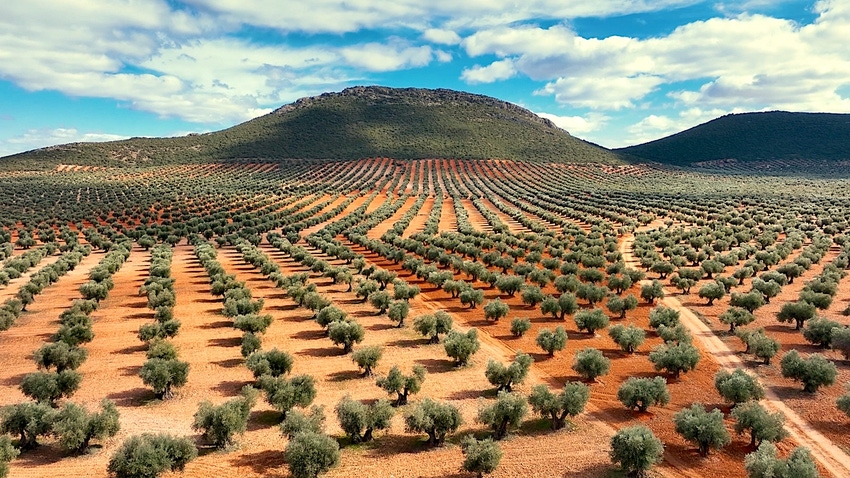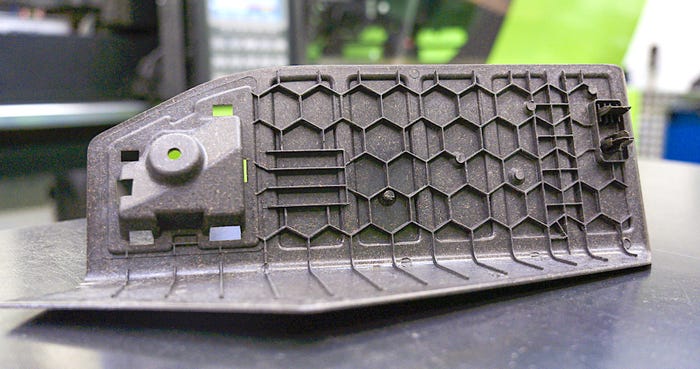Ford Tests Olive Industry Waste as Plastic Additive
Ford has produced injection-molded plastic parts containing ground-up olive branches to test feasibility.

Ford has produced injection-molded plastic parts containing ground-up olive branches to test feasibility.
When the rain in Spain falls mainly on the plain, it is watering that country’s immense olive tree groves. Spain is the world’s largest producer of olives, which is appreciated by olive oil aficionados and martini drinkers alike.
However, olive trees require annual pruning to keep them in peak health, and these pruned branches present a headache for olive producers because of the sheer volume of organic waste generated every year.
The scale of Spain’s olive production, which covers more than 6 million acres, is hard to conceive, reports Inga Wehmeyer, project leader for Ford’s effort to find practical uses for those pruned branches. “It is impressive,” she said of a field trip to Spain’s olive production center. “It is a two-hour drive, just through olive trees.”
Ford launched its project to develop potential production uses for Spain’s olive branches a few years ago as part of the COMPOlive project, which seeks to develop commercial uses for the organic waste from the olive industry, Wehmeyer said. “Our partners in Spain had the idea,” she recalled. “They are keen on the idea of finding any kind of solution for the olive tree waste.”
Because this is waste material, its use in production parts would have no environmental impact, she pointed out. “One major benefit is that these fibers are usually waste, they won’t be used for anything else,” said Wehmeyer. “So we don’t have any additional land usage or water consumption to grow these fibers.”
Ford’s test project succeeded in making injection-molded plastic parts containing a blend of 40 percent ground olive branches. Mixing in more of the organic material is probably not practical, so plastic use can’t be eliminated, but replacing 40 percent of the polypropylene plastic is a start. Eliminating some of Spain’s waste material is another useful benefit.
Adding the branch material makes the plastic more brittle than the pure plastic parts, Wehmeyer reported. That makes it unsuitable for use in locations that are high in the cabin of cars, where the plastic needs to be flexible during crashes and crash testing. “Natural fibers tend to be a bit brittle,” she said. “So 40 percent is quite high to be able to meet the requirements.”
Ford tested this material by making a footrest for a Focus compact car. “It could never be for a part near the head,” Wehmeyer said. “The A-pillar has high requirements for brittleness, but a part for the lower area is realistic to meet the requirements.”
Ford models the crash characteristics of the part to make necessary adjustments in the recipe. They also model the flow characteristics of that material as it is injected into the mold. Using ground olive branches introduces some challenges.
“You need a good flowability of the material,” Wehmeyer explained. Ford is using a lower-viscosity plastic to offset the thickening caused by the olive fibers. Normally, a manufacturer could heat the tooling to improve the flowability of the material into the mold, but that’s not an option because overheating the material will burn the olive fibers, Wehmeyer said. So cooler tooling makes the flowability even worse.

Flecks of olive fibers are visible in this plastic footrest. FORD MOTOR CO.
Getting material to flow uniformly to the edges of the mold is crucial for a good appearance. “Usually, with 40 percent fibers you wouldn’t get good edges,” she said. However, finding the right balance between viscosity and temperature let Ford engineers prove the potential of the process for production.
Now it is just a matter of Ford deciding that it wants to begin using recovered olive tree waste in its interior trim parts. The company has no plans so far to do that, but if they decide to, “the next step would be to involve a compounder with bigger machines,” than were used to make the test parts, said Wehmeyer.
About the Author(s)
You May Also Like





